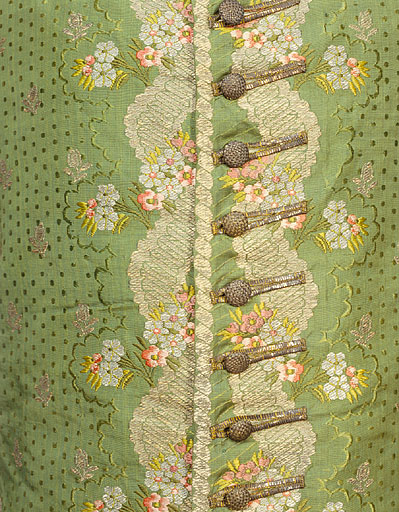waistcoat
Summary
Green silk waistcoat with woven spot and brocaded silver sprig. Floral border brocaded in silver and silk in shades of pink, mauve and green; back green glazed woollen satin; back and front to waist lined white cotton and linen; front edges and skirt lined cream wool fronts fastening with twelve silver thread covered buttons and buttonholes from round neck to waist seam; pocket at waist seam each side, white cotton and linen, shaped flap lined cream wool; flared skirt, curving away very slightly in front, open and flared at sides, open below waist at back; back in two shaped sections.
Display Label
For centuries, the waistcoat was one of the chief areas for decoration in men's dress. During the eighteenth century, waistcoats often matched the coat or jacket and the breeches, either in fabrics like silk brocades, damasks or velvets, or in embroidered decoration in court suits. The main image shows a sky blue silk damask waistcoat which was made of the same fabric as a banyan or gown, and worn as an outfit. By the later eighteenth century waistcoats shortened and ended in a horizontal line at the waist. New fabrics like cotton became fashionable, often embroidered in stylised neo-classical designs. During the nineteenth century, the waistcoat if anything became more of a focus for attention, with the vibrant damasks and brocades contrasting with the increasingly dark, plain and sober cloth suits. Today, 2-piece suits are popular, and it is more often the jazzy tie which lifts the monochrome tone of the outer fabric, and which reveals a little of the character of the wearer.
Object Name
waistcoat
Date Created
1755-1765
Dimensions
Length: 82.5cm
accession number
1956.203
Place of creation
England
Medium
Legal
© Manchester Art Gallery




